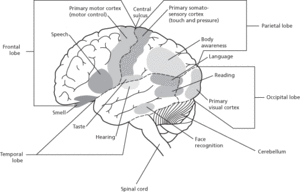The largest part of the vertebrate brain. It consists of paired left and right cerebral hemispheres, which develop from the embryonic forebrain. The hemispheres have an outer convoluted layer of grey matter—the cerebral cortex—which contains an estimated ten billion nerve cells. Underneath this is white matter, deep within which lie the basal ganglia, responsible for processing information from the cortex. The two halves of the cerebrum are linked by the corpus callosum. The function of the cerebrum is to integrate complex sensory and neural functions. The cerebrum plays a critical role in the process of learning, which involves both short-term and long-term memory. Anatomically, each cerebral hemisphere is divided into four lobes—frontal, parietal, temporal, and occipital lobes—and different functions can be localized to certain areas of each lobe (see illustration). Just in front of the gulley (central sulcus) dividing the frontal and parietal lobes is a strip of frontal cortex called the primary motor cortex. Neurons in this region control muscles in particular parts of the body. The strip of parietal cortex just behind the central sulcus is called the primary somatosensory cortex. This receives sensory information from the body, relayed via the thalamus. Apart from motor or sensory functions, each lobe also integrates the mass of information received, whether from inside or outside the body, or from memory. Higher functions such as speech, reading, writing, planning, problem-solving, and emotion also reside in the cerebrum. For many bodily functions outside the head, the left cerebral hemisphere serves chiefly the right side of the body, and the right hemisphere the left side. However, some functions reside primarily in one or other hemisphere; for instance, language ability is most often centred in the left hemisphere (see lateralization). See also neocortex.

Cerebrum: the lobes of one cerebral hemisphere showing functions associated with different areas
- psychological hedonism
- psychologism
- psychometrics
- Psychometric Society
- Psychometrika
- psychophysical laws
- psychophysical parallelism
- psychrometer
- psychrometric chart
- psychrometry
- psychrophile
- psychrophilic
- ptarmigan
- Pteraspida
- Pteraspis
- Pteridophyta
- pteridophyte
- pteridophytes
- Pteridospermales
- pterobranch
- Pterobranchia
- pterodactyl
- pterodactyls
- pteropod ooze
- Pteropsida